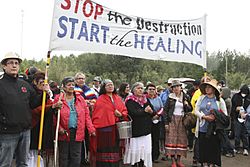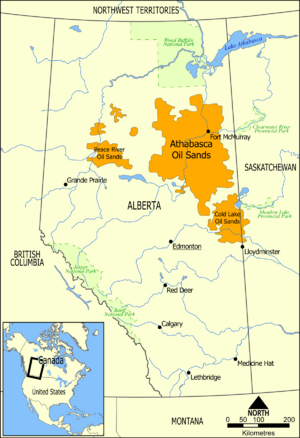Tar Sands Healing Walk facts for kids
Quick facts for kids Tar Sands Healing Walk |
|
|---|---|

2013 participants
|
|
| Genre | Grassroots demonstration |
| Begins | August 14, 2010 |
| Ends | June 28, 2014 |
| Frequency | Annual |
| Location(s) | Fort McMurray, Alberta, Canada |
| Founders | Eriel Deranger, Melina Laboucan-Massimo, Cleo Reece |
| Participants | First Nations, Métis, Inuit, various environmental groups, and citizens of the Athabasca River watershed |
The Tar Sands Healing Walk was an annual prayer walk. It was about 14 kilometers (9 miles) long. People walked to protest the mining of crude oil in the Athabasca tar sands. The walk started in 2010. It began north of Fort McMurray, Alberta, at a place called the Syncrude Loop. The path went right through the main tar sands mining area.
Local Indigenous Elders led the walk. They prayed for the land to heal. They also wanted to show people the harmful effects of tar sands mining. The walk was created by Indigenous women. These women were from First Nations communities affected by tar sands projects. They included Cleo Reece, Eriel Tchekwie Deranger, and Melina Laboucan-Massimo.
Groups like Greenpeace and Sierra Club helped support the walk. The last walk happened in 2014. The organizers felt they had achieved their goal of raising awareness.
Contents
Why the Healing Walk Started
The first walks were organized by local communities. Other groups and friends also helped. In later years, Keepers of the Athabasca became a main supporter. This group includes First Nations, Métis, Inuit, and environmental groups. Jesse Cardinal helped coordinate the yearly event.
The walk grew to include a special camp. This camp offered education and spiritual activities. For five years, the Tar Sands Healing Walk brought many people together. They walked to protect their culture, the environment, and the climate. They wanted to stop the tar sands from growing.
The prayer walk aimed to show the impacts of tar sands development. Jesse Cardinal said, "Protests and marches are good, but we felt people needed something more spiritual." She added that it was about connecting with the land. The walk was also a response to concerns about Indigenous treaty rights.
Hundreds of people came from all over North America. They joined this yearly healing ceremony. The walk took place on the traditional lands of the Cree, Dene, and Métis peoples. These lands are in northern Alberta. Tar sands mining has greatly affected this area and its people.
Eriel Deranger, one of the founders, said the walk was about building community. She wanted to connect people who were negatively affected by the industry. This helped them support each other on their journey.
Many participants camped at Indian Beach Campsite in Anzac. This site is near Fort McMurray and the Athabasca Oil Sands. Native elders from across North America led the walks. They guided people past lakes of tailings (wastewater) and industrial sites. The route was about 14 to 16 kilometers long. The 2014 walk was the last official one. Jesse Cardinal explained, "It's time to show light on other communities impacted by tar sands." She added, "To stop the destruction, healing must start everywhere."
Main Concerns of the Walk
The walk helped bring attention to human rights issues in Canada. It also highlighted the serious effects of the Athabasca Oil Sands on First Nations people. Local rights to clean air and water are part of historical agreements. These are Treaty 8 and Treaty 6. Both are protected by the Canadian Constitution.
Under these treaties, Indigenous peoples have the right to hunt, trap, and fish. They can do this on their traditional lands forever. But oil sands projects threaten their traditional way of life. They destroy the natural homes of animals and fish.
The Canadian oil sands are a huge industrial project. Yet, many Canadians do not know how fast it is growing. They also don't know its effects on the environment, economy, and society. In 2012, Alberta's tar sands produced about 1.9 million barrels of oil each day. If plans are approved, this could reach 5 million barrels per day by 2030. In 2013, a large oil spill happened in Cold Lake. It still causes problems for people there.
Experts from Simon Fraser University asked for a pause on new tar sands projects. They want a better plan for sustainable energy in North America.
Health of Indigenous People
Since 2007, health officials have noted a problem. First Nations communities living downstream of the oil sands have higher rates of rare cancers and brain tumors. Arsenic, a chemical that can cause cancer, is created by oil production. Arsenic has been found in water, soil, and even in melted snow in the area.
Harmful chemicals are everywhere. Cancer rates are very high, especially for women and children. This is due to chemicals in the water and air. These chemicals are now a part of the land. For Indigenous people, these health problems are a serious concern.
Cancer and asthma rates in Northern Alberta are higher than in most of Canada. They are also higher for Indigenous people than for non-Indigenous people. The average life expectancy for Indigenous people is five years less.
With current oil sands development, woodland caribou populations are expected to disappear. This is a problem for Indigenous hunting traditions in Canada. It threatens their food supply. It also adds to health issues for both people and the environment.
Women's Voices and Health
A report called In Solidarity with the Healing Walk talks about how climate change affects Indigenous women and children. Few sources discuss these issues from women's viewpoints. Women's voices are often not heard in politics, especially in Indigenous politics. Their families are more affected by rare cancers. Their children suffer higher rates of asthma. This is true for those living near the environmental impact zone.
Eriel Tchekwie Deranger, a founder of the walk, says her community is suffering greatly. She states that their traditional way of life is disappearing. Indigenous women are deeply affected by the tar sands. This is seen as a continuation of colonization.
Human Rights Concerns
Amnesty International suggested that the Canadian government should respect Indigenous rights. This is important when giving permits for mining, logging, and oil extraction. The growth of the tar sands is seen as an attack on First Nations rights. It moves Indigenous people from their homes. It also removes important environmental protections.
The Beaver Lake Cree Nation has recorded 20,000 treaty rights violations. These are linked to the expansion of the tar sands. Eighty percent of the traditional lands of the Athabasca Chipewyan First Nation and the Cree First Nation are often blocked. This is due to oil sands development. The land that can be reached is badly damaged.
Environmental Health
Climate activist Bill McKibben says that if oil sands development continues, it will cause lasting damage to the planet. Even though oil development helps Canada's economy, McKibben suggests it's time to create green energy jobs.
Oil sands cover about 140,000 square kilometers of Alberta. This area is about the size of Florida. Oil sands leases cover about 20% of the province's land. In 46 years of development, only 0.15% of the disturbed land is officially "reclaimed." It is not possible to return the boreal forest to its natural state. Over 30 million birds are expected to be lost in the next 20 years due to tar sands development.
Climate Impact
Greenhouse gas emissions come from Canada's tar sands. These gases affect the global climate. The use of the oil sands is the main reason Canada will not meet its goals for reducing greenhouse gases. Canada's climate performance is the worst in the Western world.
More than 600 million cubic feet of natural gas are used daily to get oil from the tar sands. This is enough gas to heat over 3 million Canadian homes every day. The International Energy Agency reports that increasing oil production will lead to a dangerous rise in global temperature. Carbon emissions from oil sands production have more than doubled in the last ten years. They are on track to double again.
Air and Water Quality
In northern Alberta, local Aboriginal communities face very poor air and water quality. The oil sands industry used about 170 million cubic meters of water in 2011. This was to extract oil. This amount is like the water used by 1.7 million Canadians at home.
Ninety-five percent of the water used in tar sands mining is so polluted it must be stored in toxic sludge pits. This means 206,000 liters of toxic waste are released every day.
"The river used to be blue. Now it’s brown. Nobody can fish or drink from it. The air is bad. This has all happened so fast," says Elsie Fabian, 63, an elder in a Native Indian community along the Athabasca River.
Canada has two of the world's three largest dams. They hold back toxic sludge from the oil sands. Eleven million liters of toxic wastewater leak from these pits into the boreal forest and Athabasca River every day. That's 4 billion liters a year. Air pollution rules in Alberta are less strict than international rules. Even so, air quality goals were missed 1,556 times in 2009. This was up from 47 times in 2004.
David Schindler, an environmental scientist, studied how water pollution was checked in the oil sands. His research showed that only the industry regulated water monitoring. This led to wrong levels of cancer-causing chemicals being reported. Chief Allan Adams of the Athabasca area is working with Schindler. They want to show proof of water pollution from the leaking pits.
Land and Wildlife
Eighty percent of the traditional land of the Mikisew Cree and Athabasca Chipewyan First Nations is often blocked. This is due to tar sands development. This is a violation of treaty rights. It directly affects their ability to fish and hunt.
If we don’t have land and we don’t have anywhere to carry out our traditional lifestyles, we lose who we are as a people. So, if there’s no land, then it’s equivalent in our estimation to genocide of a people," says George Poitras of the Mikisew Cree First Nation.
Hunting is a traditional way of life for Indigenous peoples in Canada. The loss of natural homes has stopped them from hunting on their own land. Pollutants from oil sands production are killing animals and fish. First Nations communities once relied on these for food. In 2007, it was suggested that wildlife was harmed by the oil sands. For example, moose were found to have high levels of arsenic. Later studies showed lower levels, but still above what is safe for animals.
See also


